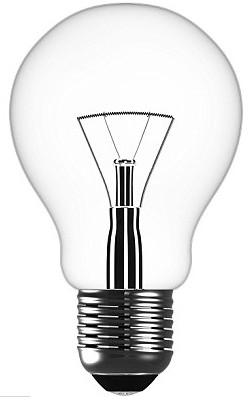Measure the Resistance of an Electric Bulb
An ordinary bulb has a thin tungsten filament. The power rating \(P\) and voltage rating \(V\) of a bulb is marked over the bulb. The resistance of the bulb is found theoretically using the formula \(R=V^2/P\). In this demonstration we measure the resistance of such a bulb using a multimeter and compare measured value with the theoretically calculated value. The results give an insight into the temperature dependence of resistance.
Apparatus
A 220 V AC source, 100 W bulb, a bulb holder, a multimeter and connecting wires.

Procedure
- Put the bulb in the bulb holder.
- The two terminals of the bulb are now connected to the wires of the holder.
- Connect these two wires to the multimeter and measure the resistance of the bulb. Note this reading.
- Now calculate the resistance of the bulb using the specifications of the power and voltage rating given on the bulb. Again note this reading. Do you notice a difference in the two readings. Why? Is the multimeter defective? Is the formula used for calculation of the resistance wrong?
Discussion
The resistance of the bulb comes out to be 484 ohm after calculations. But the multimeter reading shows a value of less than 50 ohm. Well, the multimeter is not defective which we prove by measuring a known resistance. The formula used is also perfectly right. But there is one thing we miss in this whole exercise. Resistance of a conductor increases with temperature. When we measure the resistance of the bulb with the multimeter, the filament is at the room temperature (about 30 degree celsius). But using the formula, the obtained resistance is the resistance of the bulb in full glow i.e., when it is connected to a 220 V and has attained a temperature at which it starts giving light. This temperature is around 3000 degree celsius. So the calculated resistance is much higher than the resistance shown in multimeter.
The resistance of a conductor varies with temperature as \(R_T=R_0[1+\alpha(T-T_0)]\), where \(R_T\) is the resistance at the temperature \(T\) and \(R_0\) is the resistance at the temperature \(T_0\) (generally the room temperature), \(\alpha\) is called the temperature coefficient of resistance. The temperature coefficient of tungsten is approximately \(4.5\times{10}^{-3}\, {/oC}\).
Hazard: Handle 220 V power supply carefully. It may be fatal.
Related
- Electrical Resistance
- Colour code for resistors
- Electrical Energy & Power
- Series and Parallel Arrangements of Resistances
- Wheatstone bridge
- Symmetry in electrical circuits
Subscribe to our channel
